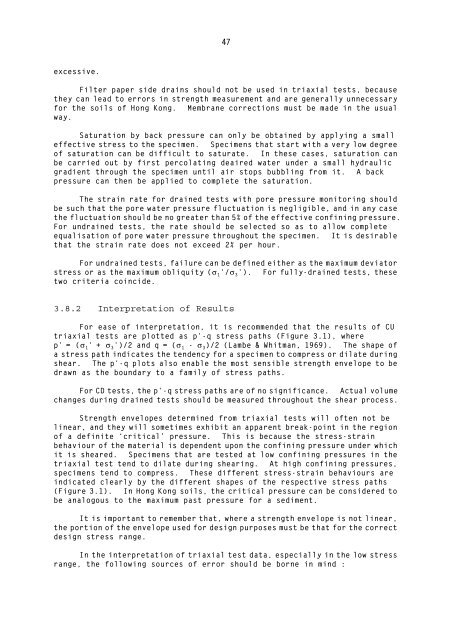Geotechnical Manual for Slopes
Geotechnical Manual for Slopes
Geotechnical Manual for Slopes
You also want an ePaper? Increase the reach of your titles
YUMPU automatically turns print PDFs into web optimized ePapers that Google loves.
47<br />
excessive.<br />
Filter paper side drains should not be used in triaxial tests, because<br />
they can lead to errors in strength measurement and are generally unnecessary<br />
<strong>for</strong> the soils of Hong Kong. Membrane corrections must be made in the usual<br />
way.<br />
Saturation by back pressure can only be obtained by applying a small<br />
effective stress to the specimen. Specimens that start with a very low degree<br />
of saturation can be difficult to saturate. In these cases, saturation can<br />
be carried out by first percolating deaired water under a small hydraulic<br />
gradient through the specimen until air stops bubbling from it. A back<br />
pressure can then be applied to complete the saturation.<br />
The strain rate <strong>for</strong> drained tests with pore pressure monitoring should<br />
be such that the pore water pressure fluctuation is negligible, and in any case<br />
the fluctuation should be no greater than 5% of the effective confining pressure.<br />
For undrained tests, the rate should be selected so as to allow complete<br />
equalisation of pore water pressure throughout the specimen. It is desirable<br />
that the strain rate does not exceed 2% per hour.<br />
For undrained tests, failure can be defined either as the maximum deviator<br />
stress or as the maximum obliquity (σ 1 '/σ 3 '). For fully-drained tests, these<br />
two criteria coincide.<br />
3.8.2 Interpretation of Results<br />
For ease of interpretation, it is recommended that the results of CU<br />
triaxial tests are plotted as p'-q stress paths (Figure 3.1), where<br />
p' = (σ 1 ' + σ 3 ')/2 and q = (σ 1 - σ 3 )/2 (Lambe & Whitman, 1969). The shape of<br />
a stress path indicates the tendency <strong>for</strong> a specimen to compress or dilate during<br />
shear. The p'-q plots also enable the most sensible strength envelope to be<br />
drawn as the boundary to a family of stress paths.<br />
For CD tests, the p'-q stress paths are of no significance. Actual volume<br />
changes during drained tests should be measured throughout the shear process.<br />
Strength envelopes determined from triaxial tests will often not be<br />
linear, and they will sometimes exhibit an apparent break-point in the region<br />
of a definite ‘critical’ pressure. This is because the stress-strain<br />
behaviour of the material is dependent upon the confining pressure under which<br />
it is sheared. Specimens that are tested at low confining pressures in the<br />
triaxial test tend to dilate during shearing. At high confining pressures,<br />
specimens tend to compress. These different stress-strain behaviours are<br />
indicated clearly by the different shapes of the respective stress paths<br />
(Figure 3.1). In Hong Kong soils, the critical pressure can be considered to<br />
be analogous to the maximum past pressure <strong>for</strong> a sediment.<br />
It is important to remember that, where a strength envelope is not linear,<br />
the portion of the envelope used <strong>for</strong> design purposes must be that <strong>for</strong> the correct<br />
design stress range.<br />
In the interpretation of triaxial test data, especially in the low stress<br />
range, the following sources of error should be borne in mind :

















